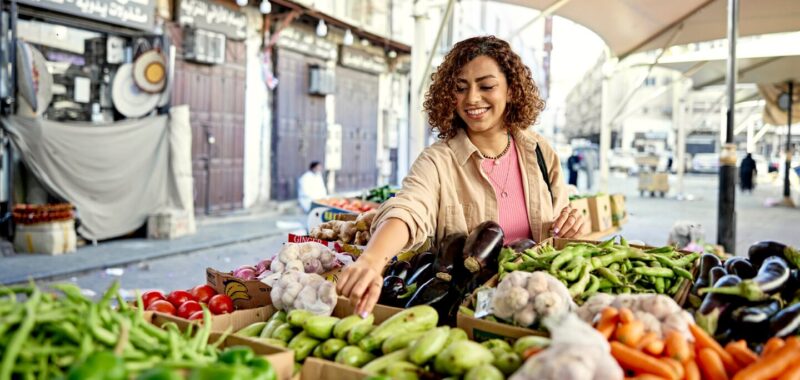Grocery bills are straining wallets across the country — and it’s no wonder. Food costs are predicted to rise 3.2% in 2025, according to the U.S. Department of Agriculture.
If you’re concerned, you’re not alone. Tariffs and rising prices were among the concerns referenced in the Conference Board’s latest Consumer Confidence Index report, which aims to measure how U.S. consumers feel about the economy. The index fell 7.9 points in April to 86 — the lowest it’s been since the onset of the pandemic.
Separately, the Conference Board, a nonprofit economic research group, said that the number of consumers expecting a recession in the next 12 months has hit a two-year high.
You can’t control the economy, but you can control how much you spend on groceries. A few changes can help you ride out price fluctuations and keep meals interesting and healthy.
Do: Be deliberate when you buy in bulk
You might be tempted to start stocking up, but buying in bulk can backfire if you end up with more than you need.
“The best way to save money is not to waste food,” says Phil Lempert, a food marketing expert and the face behind Supermarketguru.com.
Lempert recommends taking inventory and making a list. “Look at what’s in your cupboards, in your freezer and your refrigerator,” he says. “Don’t overbuy.”
If you want to make the most of your membership to a store that sells in bulk, purchase things that won’t expire, such as cleaning products and personal care items.
As for food, shelf-stable items can also be a good bet. Rice, beans, pasta, oats and flour are filling and the foundation for many meals.
Consider how you store food, too. Reusing glass jars from pasta sauce or jam and investing in a vacuum sealer can help you keep food longer.
Don’t: Skip farmers markets and farm stands
Where you live, how many people are in your home, and your dietary restrictions can shape your grocery bill.
This is where local farmers markets and farm stands can be helpful. It might be tempting to write them off as too expensive or artisanal, but that’s not always the case.
Buying local produce at farmers markets and farm stands offers the chance to eat seasonally, which will be important in the coming months.
Lempert predicts grocery chains might start carrying a smaller assortment of products in response to tariffs — but he doesn’t see that as a bad thing.
“We’re just going to be buying things that are in season,” he says. “They’re going to be tastier, they’re going to be less expensive, and they’re going to have more nutrients.”
Those foods are also likely to last longer than what you would buy at the grocery store. At the farmers market, there’s no middleman, and the transportation time from the farm to your table is shorter.
If buying organic is important to you, farmers markets may help make those purchases more affordable, says Kamila Elliott, an Atlanta-based certified financial planner.
Tapping into your community can lead to personal relationships and the ability to negotiate. Many markets also accept EBT and SNAP benefits that can provide more value than grocery chains.
Do: Store-hop to find the best deals
Making one extra stop can save you more than you think.
“People are shopping around,” Lempert says. “People are now willing to go to Aldi, Grocery Outlet, to Smart and Final and other stores in order to save money.”
These discounted grocers pass on savings to consumers through generic brands and lower overhead costs. But there can be downsides: limited stock, and some don’t accept manufacturer’s coupons.
To stretch your grocery budget, make multiple stops at a mix of discount and traditional retailers to take advantage of deals and discounts. Check out weekly flyers and coupons you can use. Plan your route to shop strategically and save gas money.
Don’t: Assume fresh is always better
The idea that fresh food is always healthier than frozen food can lead to overspending. The reality is that frozen food, which is typically less expensive, can be just as nutritious. Frozen produce is picked at its peak and flash-frozen to retain the nutrients.
Cost savings also apply to some frozen meats. For example, Lempert says that buying frozen fish can cost about 40% less than fresh.
Replacing out-of-season fresh produce and some meats with their frozen counterparts is an easy way to save money, and you’re not racing against an expiration date.
More ways to save on groceries in any economy
Take inventory and plan your meals: Taking stock of what’s already in your pantry and freezer can save you big and prevent unnecessary purchases.
Make a list and stick to it: Shopping without a sense of purpose can lead to overspending, impulse purchases and lots of ingredients but no coherent meals. Use a grocery list app so you’ll have the list at your fingertips.
Leave your emotions at the door: Check in with yourself before you shop. “If you’re already tight on your budget and you go hungry, stressed or rushed, then most likely it’s a given you’re going to go over your budget,” says Elaine King, a Miami-based CFP.
Budget for treats: When times get tough, it’s hard to cut out all the fun. King suggests using the 80/20 rule: 80% of our grocery budget should go toward nutritious foods, leaving 20% to spend on treats or things you look forward to eating.
Don’t downplay leftovers: Saving your leftovers or doubling a recipe and storing the second batch in the freezer for later are great ways to save time and money. You’ll have a meal ready for a day when schedules are tight or you’re tempted to spend money on takeout.

